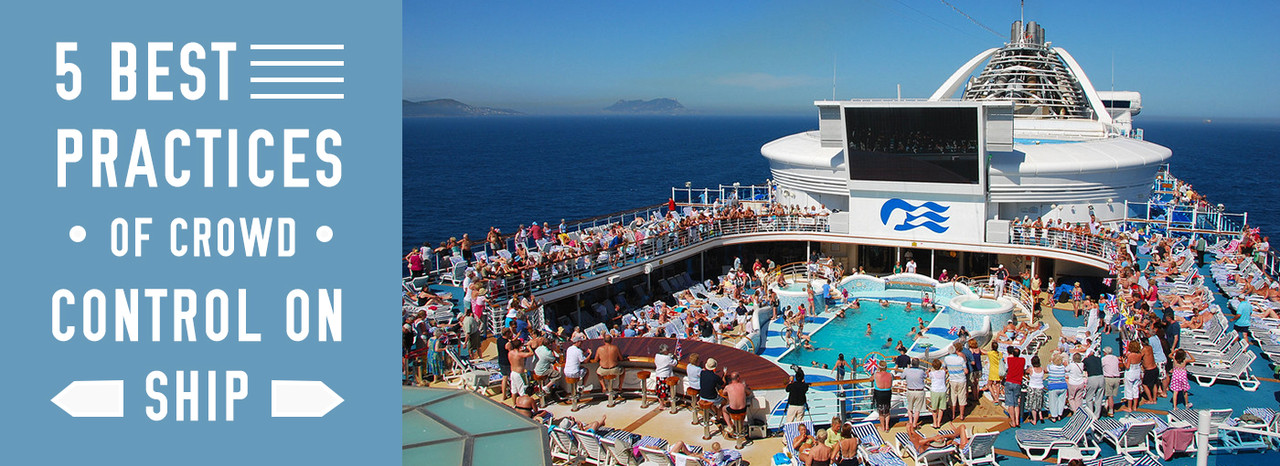As part of our extensive series on best practices for crowd control, we’re continuing the series by diving into another important topic: crowd management and control techniques on a ship or other maritime environment.
Cruise ships and other seafaring vehicles present a unique series of challenges and obstacles when designing a crowd control plan. There are plenty of instances of cruises going wrong, most famously, the Carnival cruise in 2013. You don’t want to be infamous for customers having a terrible experience at sea, or even worse, have injuries or deaths due to poor planning. Here, we’ll list 5 best practices for making sure that you’re prepared for the worst, and that you can be ready to face any obstacle on the high seas.
1. Understand the psychology of the crowd
It pays to educate yourself around how crowd psychology works, so you can plan accordingly. This can be difficult, as there are many differing opinions about so-called “mob mentality” works.
We’re not crowd psychologists, nor do we pretend to be them online. But, if you do some reading, you can see that there’s basically two camps:
- In a crisis situation, a mob will behave according to “unrestrained impulses.”
- Even in a crisis situation, mobs are able to respond to directions and stimuli.
For your purposes, when designing a safe crowd control plan at sea, it’s likely best to assume that both are true; in a mob or crowd situation, people will likely behave badly, but they will also be receptive to direction and control. Having a strong plan and a ship layout that is conducive to potential catastrophe resolution will go a long way toward keeping your passengers safe.
2. Prepare for anything
If you’re prepared for anything, you’re prepared for everything.
Circular logic aside, making sure that your marine safety and crowd control plan has protocols for every possible contingency, and your crew is appropriately prepared for those contingencies is of maximum importance. Here is a list to get you started for incidents where you might need to prepare for serious crowd control issues:
- Natural Disasters - Rogue waves, intense storms, fallout from hurricanes and natural disasters in ports, fires, lightning strikes.
- Human Disasters - Pathogens like norovirus, vandalism, people attempting to incite riots, arson, altercations between passengers.
- Events - Concerts, trade shows, major events, dances, etc.
- Logistics Problems - Food shortage, clean water shortage, sanitation issues, mechanical problems, etc.
The key is to be ready, and not be caught unawares without a plan for trouble.
3. Crowd pacification
In the event of an emergency, you’re going to be dealing with a crowd full of a variety of people. Some of them might be under the influence of alcohol and other substances. Some might be terrified and looking to your crew and staff for safety and reassurance. Others might just be running around like maniacs.
It’s important to ensure that you’re familiar with crowd pacification techniques as well as the necessary terminology that goes along with it.
At sea, stairway control and safety is going to be of primary concern. A crowd that is mobbing stairways is a prime place for disasters and problems to occur. You don’t want people being trampled or injured, so making sure that you’ve got the right training and plan to manage stairways and stairwells is crucial.
Additional, a key tool in the crowd pacification toolbox is going to be mustering stations. You want to make sure these are clearly delineated around the ship, and that all crewmembers are aware and ready to respond at their designated mustering station. Having a plan and running drills so crew can get to these stations and be ready to direct and pacify a crowd is essential.
4. Training, training, training
Of all the things on the list, training your crew to respond well to crisis situation is likely the most important. When bad stuff happens, your people are going to be the first and last line of defense against dangerous situations.
One of the best pieces of management advice we’ve ever come across is this: train your people so that they can leave. It’s a counterintuitive piece of advice, but people whose supervisors and managers demonstrated investment in their success and skill training are much more likely to stick around. More loyal, experienced, and trained staff equals better crowd control and crisis response. If you’re looking for some ways to begin training your crew to have a better idea of crowd management strategies, these courses are a great place to start.
5. Have the right equipment
Finally, you need to have the right equipment to help facilitate crowd control procedures in the event of an emergency. Making sure that exits are clearly market with quality signage, and that your employees have the proper tools to ensure that people are going the way they need to when they need to do it. Trashcans Unlimited offers crowd control barriers, stanchions, and warning posts that can help direct the flow of traffic in non-emergency situations. We also have a large supply of bollards, which can be useful in breaking up the flow so employees can manage a filtering crowd.
With us, you’ll be able to find the right equipment to help you stay safe out on the high seas, regardless of the waves that get thrown at you. If you have questions, or need information about which crowd control equipment will be most useful for your situation, get in touch with us. We’re here to help.


